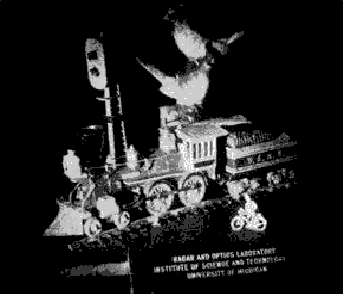|
... II. The Framework ...
values

 paradoxes
paradoxes
|
Holography
Baby boomers tend to think of holography as the eye catching three-dimensional (3-D) display of pieces of a chess set,
or the train and bird shown in Figure 16. However, the holographic framework being referred to as a framework for science and religion is not the 3-D
displays, rather it is the transform, or the mathematics behind how the 3-D display is generated.

Figure 16. "Train and Bird" is the first hologram ever made with a laser using the off-axis technique. This pioneer
image was produced in 1964 by Emmett Leith and Juris Upatnieks at the University of Michigan only four years after invention of the
laser. 2.10
A traditional hologram consists of a laser, beam splitters, and film. There is a data collection phase and a data display phase.
In data collection an interference pattern is captured on film. The object to be displayed is illuminated with laser light. The unique characteristic of laser light is
that it consists of a single frequency. This laser light is passed through a beam splitter, which allows the object to be illuminated with the mono-frequency light
and the film to be illuminated with the same mono-frequency light. In addition, light reflected from the illuminated object also illuminates the film. Because both
the original laser light and the reflected light are exactly the same frequency, the image recorded on the film is an interference pattern between these two light
sources, not a traditional image. The reason there is an interference pattern is because light reflected off of the 3-D object has to travel different distances to
get from the laser to the illuminated portion of the object and then to the film. The three-dimensionality of the illuminated object creates the interference pattern.
|
timedex

 infinite grid
infinite grid
-052-
|